If you have never had an opportunity to go winery touring in Rioja, but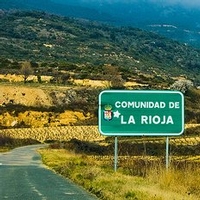 have an interest in what the experience might be like, then read on. I hit 18 bodegas in an ultra-intense four-day stretch recently, and, having now largely recovered, I can report that Rioja is one of the world’s most interesting and pleasurable destinations for wine lovers and trade members. You might to wish to adopt a somewhat slower pace than the one I set (since the experience was rather like drinking from a fire hose), but if you love learning about the world of wine, this is a part of it that you must not miss.
have an interest in what the experience might be like, then read on. I hit 18 bodegas in an ultra-intense four-day stretch recently, and, having now largely recovered, I can report that Rioja is one of the world’s most interesting and pleasurable destinations for wine lovers and trade members. You might to wish to adopt a somewhat slower pace than the one I set (since the experience was rather like drinking from a fire hose), but if you love learning about the world of wine, this is a part of it that you must not miss.
* * *
I’ve seen my share of wineries over the years, having conducted just under 1,000 visits around the world, but have never quite managed to get my fill of Rioja. Having just a couple of quick passes through the region, I was determined to really get up to speed on the place and its wines. So, I did what any wine writer would do in this situation: I begged.
ICEX, the Spanish Institute for Foreign Trade, kindly granted my requests for logistical assistance with appointments and help from a translator/guide. I sent a long list of bodegas I wished to see, along with a plea to set as many appointments as it might be humanly possible to keep. This plea was also accepted--but only against the better judgment of those helping set my schedule.
Getting a good start is especially important to a hectic trip, but I didn’t get one in this case. Equipment problems delayed my flight from Washington to New York by two hours, and I made the connection for my flight to Madrid in a serious panic and a full sweat just as the doors to the plane were being closed. This was a harbinger of things to come.
* * *
One thing that did not come is my suitcase. Given the hasty connection in New York, however, this is not exactly a shock to me in Madrid, so I struggle to keep my optimism intact while working through the missing bag and rental car pickup processes.
I leave the airport behind schedule but at high speed in a brand new rented Citroen, fueled by diesel and a thermos of coffee that I packed to help get me out of Madrid and onto the right roads to Logroño. Finding my way proves much easier than expected, as I should report to all who have never driven in Spain. The roads are excellent, the drivers are very good, and the signage is adequate.
I arrive at my hotel in Logroño only 20 minutes late, which is no scandal by Spanish standards of punctuality. I am greeted by my host from ICEX who turns out, to my relief, quite capable in English and very pleasant. Along with her is a fellow who turns out, to my horror, to be a reporter from the regional newspaper.
He seems like a nice guy, but I’m in Rioja to ask questions rather than answer them, and am not too keen on fielding queries when fried from sleep shortage, jet lag and road weariness. So I answer his questions while groping for a middle ground between responses so bland that I’ll seem like an idiot and ones so pointed that I’ll seem like a jerk, and get up to my room as quickly as possible for a shower before heading out for the first bodega visit.
The shower feels great, though I then have no option but to put on the same clothes I’ve been wearing since Washington. Duty calls, however, so I dress and ready myself for departure by ripping my room key off the huge lucite block attached to the ring (since, being a typically headstrong American, I do not want to be relinquishing and retrieving my key every time I head in or out of the hotel all week). It is now 7:00 p.m. I’m already an hour late, and as I fire up the Citroen, I’m wondering, “this trip was a good idea, wasn’t it?”
* * *
The first visit restores my faith, though not immediately. My host, Sonia, directs me off the main road and onto a deeply rutted, not-too-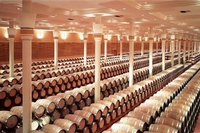 promising dirt path that bounces us pretty badly for hundreds of yards before terminating at a set of incongruously magnificent gates. They swing open to reveal Finca Valpiedra, a very large and impressive estate that is the jewel of the Conde de Valdemar properties. Perched on a hillside above the Ebro River, with amazing panoramic views, the estate is absolutely gorgeous. So too are the wines, as I’m able to confirm, following a look at the vineyard and winery, by tasting every one ever made here.
promising dirt path that bounces us pretty badly for hundreds of yards before terminating at a set of incongruously magnificent gates. They swing open to reveal Finca Valpiedra, a very large and impressive estate that is the jewel of the Conde de Valdemar properties. Perched on a hillside above the Ebro River, with amazing panoramic views, the estate is absolutely gorgeous. So too are the wines, as I’m able to confirm, following a look at the vineyard and winery, by tasting every one ever made here.
After a delicious dinner, we drive back to my hotel in Logroño, which, as luck would have it, is situated near several department stores. Sonia is a bit of a clothes horse, and knows just where to direct me for some early morning shopping so that I won’t need to spend yet another day in the same set of clothing. Confident that I’ll find some things in the morning to tide me over until my bag makes it up from Madrid, I flop into bed assured that things are on the upswing.
* * *
Reconsidered in the clear light of day, that assurance seems to have been a bit premature. It turns out that the stores don’t open until 10:00 a.m., and my first appointment is set for 9:30 in Oyón, which is a good 20 minutes away. This is a frightening development, since the day’s schedule seems impossible to keep even under the best of circumstances. With an agenda including four bodega visits, a tour of a new wine museum, and a necessarily protracted lunch and dinner in the Spanish mode, we are in trouble. So, I bust into the biggest of the department stores precisely at the stroke of 10:00, grab some essentials, and whip back to the hotel for a quick change.
Sonia is waiting in the lobby, looking understanding and polite but also slightly freaked out by our schedule crisis, so I change quickly and drive even more quickly to our visit at Conde de Valdemar. The good news is that we have already met our host, Oscar, during the preceding evening, and he is therefore acquainted with my baggage plight. The bad news is that another guy is lying in wait for us in the bodega’s reception area, and he turns out to be a photographer from the newspaper.
drive even more quickly to our visit at Conde de Valdemar. The good news is that we have already met our host, Oscar, during the preceding evening, and he is therefore acquainted with my baggage plight. The bad news is that another guy is lying in wait for us in the bodega’s reception area, and he turns out to be a photographer from the newspaper.
Short on my beauty sleep and wearing ill-fitting clothes still creased from the store shelves, I’m no keener on working with this guy than I was with the reporter. Oscar mercifully agrees to dispense with a tour of the winery in the interest of my schedule, and leads all of us into a tasting room for a quick run through a dozen wines. Luckily, the photographer seems interested only in shots in which I have a glass in my face, which is very much to my advantage, appearance-wise.
* * *
At this point, we really start picking up speed. Late morning and much of the afternoon are spent quickly visiting some impressive vineyards and bodegas of the Sierra Cantabria group, concluding with a superb tasting at the Señorio de San Vicente winery in the lovely town of San Vicente de la Sonsierra.
All the bottles join us for lunch in the town at Casa Toni, an amazing restaurant with a menu split evenly between foods that are firmly traditional and riotously modern, with an equally bifurcated clientele split between well-heeled bankers and muddy-heeled vineyard workers. The meal lurches back and forth between these extremes, including items such as a Fois Gras Napoleon with Goat Cheese and Port Sauce, but also rabbit kidneys and brains, as well as Patorrillo a la Riojana (feet and tripe of lamb). I do not want to leave the place (the likes of which I have never seen anywhere in the world), but know that I had better get out, as we’re late and I’m growing dangerously fond of the wines.
Once outside, the phenomenal intensity of the Spanish sun snaps me back into a more businesslike mode, and we go tearing off toward Briones for a three-hour visit I’ve been regarding with real apprehension: The Dinastía Vivanco winery, which I didn’t ask to see, and its adjacent stablemate "attraction," the brand-new Museo de la Cultura del Vino.
I’m braced for the worst, as wine museums everywhere are hopelessly hokey, but the misfortune of others works to my advantage in what seems like a Bacchic miracle. The owner has been called away due to a fire in one of the company’s bodegas. Moreover, his son is sick in bed, and no one else has been deemed capable of showing us around. This means I get to skip the no-doubt-fascinating bottling line and get straight to the wines, which turn out to be quite good. Even more fortuitously, Sonia and I get to tear through the museum at our own pace, and far-fetched as this may seem, the collection is fantastic, including astonishing antiquities and important wine-related art.
We hit the road for the day’s last visit at Remelluri ahead of schedule, 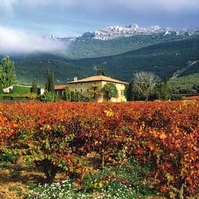 and my luck is running so strong that during the drive I begin fantasizing about an early end to the evening and a full night’s sleep. But this is Spain, and my fantasy is snuffed shortly after our arrival. We are greeted by proprietors Jaime and Amaya Rodriguez Salis, highly-civilized people who have reviewed my rat-race itinerary and who insist on imposing some sanity--whether I like it or not.
and my luck is running so strong that during the drive I begin fantasizing about an early end to the evening and a full night’s sleep. But this is Spain, and my fantasy is snuffed shortly after our arrival. We are greeted by proprietors Jaime and Amaya Rodriguez Salis, highly-civilized people who have reviewed my rat-race itinerary and who insist on imposing some sanity--whether I like it or not.
We spend an hour chatting under a shade tree, then another hour on a lazy drive through the vineyards, then another hour seeing the vegetable garden and an old hermitage and a medieval necropolis on the estate grounds, and then still more time just watching the sunset and shooting the breeze. Jaime is very serious about making wine, but he and Amaya would much rather talk about life, so about five minutes are devoted to seeing the winemaking facilities, and tasting of the (excellent) wines is merged into an extended dinner with the entire family. This is all totally contrary to my hyperkinetic way of doing things, but I’m so thoroughly charmed that I’m unperturbed even by a late return to a hotel room that--still--contains no suitcase.
* * *
The next day is a study in contrasts. The morning visit is to Finca Allende in Briones, a no-nonsense operation run out of an unrenovated 18th century building that fronts a starkly utilitarian winery. The attention of the proprietors (who are nowhere to be seen) must be fixed on viticulture and winemaking, because the wines are delicious despite the fact that the place isn’t, um, much to look at.
Next is historic Marqués de Riscal, where spectacular investments are being made precisely to make the place something to look at. Looming over the entire site are cranes erecting a hotel and restaurant designed by Frank Gehry, the architect behind many rather wild but also wildly acclaimed buildings like the Guggenheim Museum in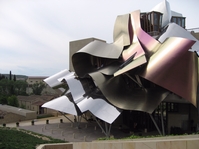 Bilbao. I’m told that when completed, the hotel will ring up at the highest cost per room of any hotel ever built anywhere, and by the looks of the model, I believe it.
Bilbao. I’m told that when completed, the hotel will ring up at the highest cost per room of any hotel ever built anywhere, and by the looks of the model, I believe it.
Despite the mind-blowing premiums placed on appearances here, I note that a thorough renovation was performed on the winemaking facilities before the hotel project began, so the order of priorities at Riscal seems sound. Pride in the past seems to be holding up well also, just like an amazing bottle from Vintage 1950 enjoyed with lunch.
Next up are the vineyards and facilities of the Arco Group, starting at the grim-looking Bodegas Langunilla. The day of discordant décor now whiplashes us back to the early 1970s, but many of the wines here (especially under the Marqués de la Concordia brand) are impressively forward-looking, and cask samples of varietal Merlot and Syrah from Rioja Baja are downright revolutionary.
Sonia is now quite understandably tiring of the proceedings. She begs off for the duration of the day, leaving me in the capable hands of the Group’s International Marketing Director, a very friendly Brit. When our work is done, we head for a beer in the striking old hilltop town of Laguardia and then back to Logroño for dinner. Turns out that we’re staying at the same hotel, and when we return there, I figure I’d better ask about my suitcase. The desk clerk responds blandly that it "has been here since yesterday." I compose myself and ask why it wasn’t placed in my room, and am told, "your key was missing, and we thought you were in the room wishing not to be disturbed." Thinking back to the bravado with which I ripped my key off the lucite block, I realize that I have, as usual, outsmarted myself.
* * *
Thursday starts very early since the contents of my suitcase include running shoes, which I need very badly as an antidote for all the wonderful food I’ve been eating. A long run is followed--however self-defeatingly--by breakfast, since fitness must take a back seat to survival, and I’ll be dead before lunch if I’m out tasting wine on an empty stomach.
This is a day for bodegas big and famous, starting with historic Marques de Murrieta. The old stone buildings are beautiful, but the place is strangely depopulated and becalmed. Some portions of the facility are being readied for a major renovation, I learn, and with this being the last Thursday in July, almost everybody in Spain is either leaving for a vacation or is already poised to depart. On such a quiet, windless morning, even the vines seem inactive. But the wines are good, so I’ll just have to come back here someday, since you can’t evaluate a sleeping racehorse.
I’m growing worried that my last two days may be anticlimactic, with all my hosts champing at the bit to hit the beach. My Spanish is awful, but adequate to pick up a lot of chatter along the lines of "where are you going on Saturday?" But it turns out that Marqués de Cáceres is buzzing with activity. This is a very big bodega, but clearly not big enough, because every building looks packed to the rafters. With 40,000 barrels, mountains of case goods, and a whizzing forklift around every blind turn, this place not only seems big and bustling, but lethally so.
A visit to the equally capacious El Coto at the end of the day offers an interesting contrast. Cáceres is both huge and hugely successful, and is Rioja’s leader in sales to the United States. They are still bringing out new wines and tweaking styles on established ones, but I get the impression that the prime concern is to hold onto what they’ve accomplished, whereas everything about El Coto suggests that these people are out to conquer the world.
The facilities are immaculate and there is an uncanny orderliness to the place. Everything and everyone seems thoroughly strategized. You’d never guess that a place this big could seem coiled for action, since we all know that elephants cannot pounce. But that is exactly the impression that I get, and also why I take trips like this: There are things you can feel when physically present in a winery that you can never sense from statistics or press releases.
* * *
My last working day begins early with another long run after another short sleep, since the preceding day ended with another big, late meal. Americans need to be very careful in Spain. If you start the day on a typical American schedule but end it on a Spanish one, you will quickly grind yourself down to nothing.
I’m feeling pretty well ground down myself, but I know this will be a great day. It starts with the most informative and impressive visit of the entire trip, at Remírez de Ganuza. Fernando Remírez leads me past the old church in Samaniego and down into what may be the most meticulously tended vineyard I’ve ever seen. After about 15 minutes it becomes clear that he has a personal relationship with every one of his vines, and that he reacts to any weed in his vineyard as you or I might react to an insect on our child. I’m thinking that nothing this clean and beautiful can possibly spring from dirt.
The bodega can’t be as impressive, right? Wrong. It is so intelligently designed in every minute detail, and so painstakingly maintained, that it could give you the creepy sensation that you’ve been lured into the lair of an obsessive nut. But it doesn’t quite have this effect, because 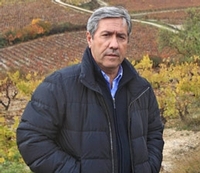 Fernando is on the right side of the fine line that separates perfectionists from obsessive nuts. When I see that there is not a single red spot on any of his barrels, I reflect that he is very close to that line, but he is all smiles and enthusiasm, without the furrowed fixation we find in fanatics. Of course, none of this would ultimately amount to anything if his wines didn’t show the fruits of his labors, but the wines turn out to be completely convincing and absolutely delicious.
Fernando is on the right side of the fine line that separates perfectionists from obsessive nuts. When I see that there is not a single red spot on any of his barrels, I reflect that he is very close to that line, but he is all smiles and enthusiasm, without the furrowed fixation we find in fanatics. Of course, none of this would ultimately amount to anything if his wines didn’t show the fruits of his labors, but the wines turn out to be completely convincing and absolutely delicious.
Next up is the brand new, ultra-modern bodega of Viña Real, which looks like a recently landed spaceship both inside and out. The layout of facility is obviously intended to minimize the need for human labor,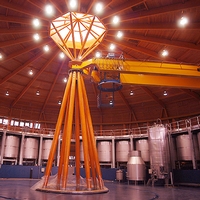 and since I’ve just come from a place that is the obvious outgrowth of a particular human’s labor, it is hard to avoid finding Viña Real lacking in soul. But it grows on me as I appreciate the ingenuity of its design, and I’m favorably impressed by the time we leave.
and since I’ve just come from a place that is the obvious outgrowth of a particular human’s labor, it is hard to avoid finding Viña Real lacking in soul. But it grows on me as I appreciate the ingenuity of its design, and I’m favorably impressed by the time we leave.
The drive to Contino is very brief, which is a good thing, because the Spanish sun and the new blacktop at Viña Real have conspired to cook the Citroen to a crisp. Contino’s bodega is nothing really remarkable, but the 150-acre vineyard is glorious. It comprises the entire interior of a huge, U-shaped bend in the Ebro, and judging from the performance of the wines, it must provide some of the best grapes in all of Rioja. Lunch here is exquisite in every respect, but also very long and very late, so Sonia and I make good our escape at a moment when our hosts are distracted by the arrival of some important retailers from Mexico.
Last stop: Pujanza. The bodega is brand new, and I asked to see it on the strength of just one wine tasted in the States, so I’m hoping that we end with a bang and not a whimper. The proprietor, Carlos San Pedro Rández, is quite young, rather shy, and apparently pretty tired, so that whimper looks likely at the outset. The vines seem healthy, but I may have seen enough vines at this point. The winery is nice enough too, but I’ve exceeded my stainless steel quota for the week. However, once Carlos gets a glass in his hand, he lights right up, and once I take a sip, I can see why. The wines are superb, and this is a guy to watch.
* * *
Dinner this last night is extremely late, having been planned for 9:00 but not actually beginning in earnest until 10:30. This is not the fault of anyone in particular (especially not Sonia, who is somehow still afloat), but I am frankly a bit peeved. An excellent meal at Las Duelas in Haro soothes me somewhat, and some wonderful old wines also have a mollifying effect, but I grow agitated once again when the entire crew of waiters gets out of the restaurant before we do.
I get over it, thanks to a nice farewell chat with Sonia on the drive back to Logroño. I drop her off, thanking her profusely but nevertheless inadequately, and head to the hotel to start packing despite the fact that it is extremely late. This seems wise, since I want to get on the road quickly after an early awakening, but by the time I finally set the little alarm in my wristwatch, I’m so tired that I can barely turn its dials. Surely I’ll feel stronger in the morning.
But there is no morning. I finally awaken, incredulous and mortified, at 1:35 p.m., having failed to set the watch properly. And while spending the rest of the day stuck in all that southbound traffic with all those happy vacationers, I’ve got plenty of time to reflect that when I do this again in Spain, I’d better slacken the pace a little.
* * *
Comments or Questions? Write to me at mfranz@winereviewonline.com